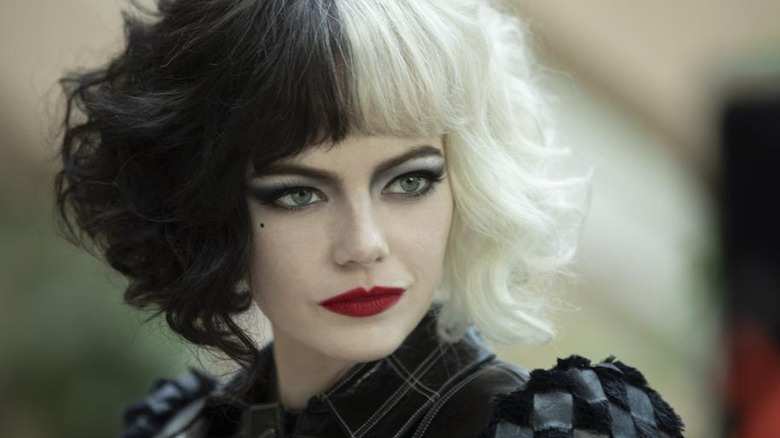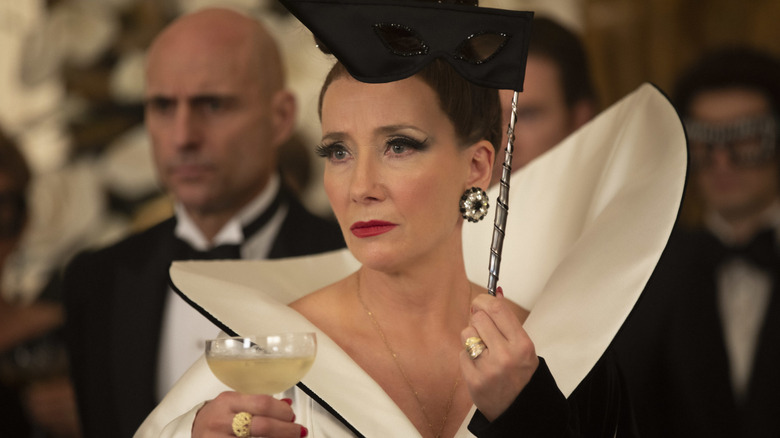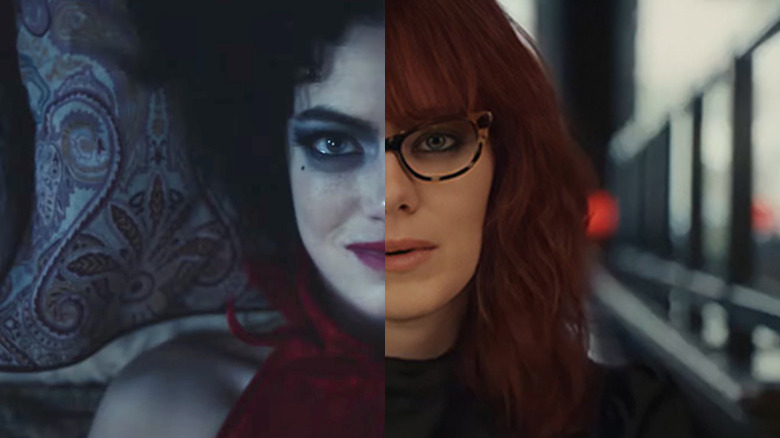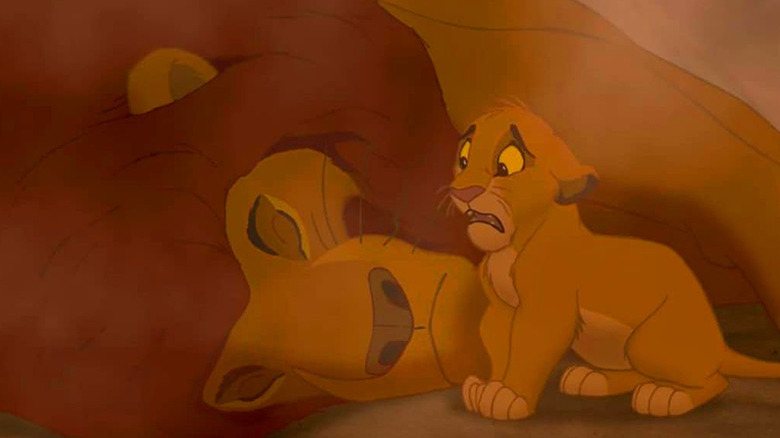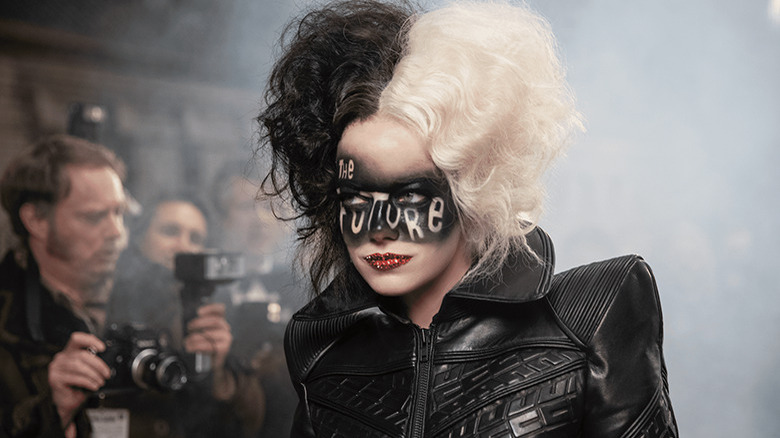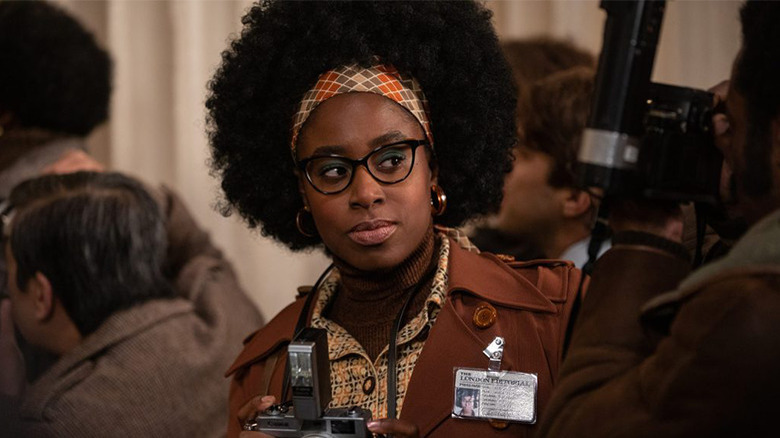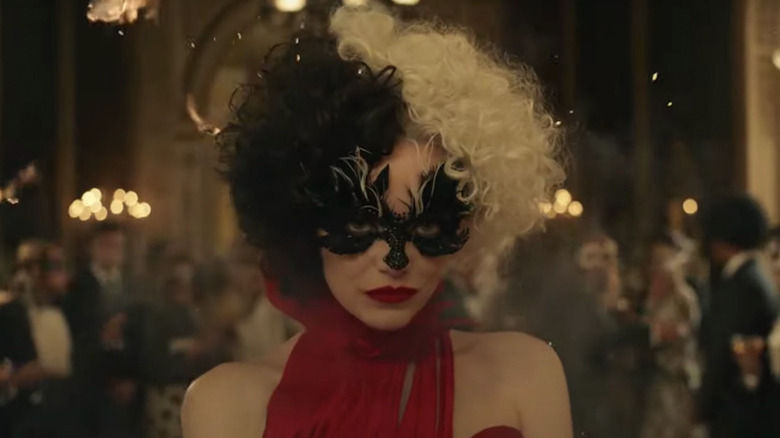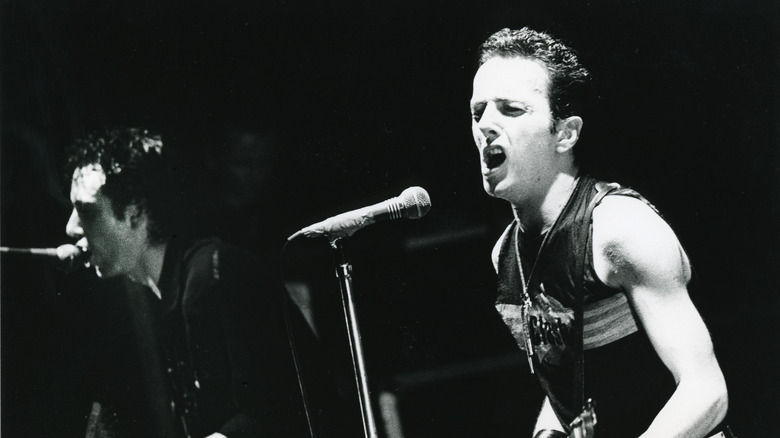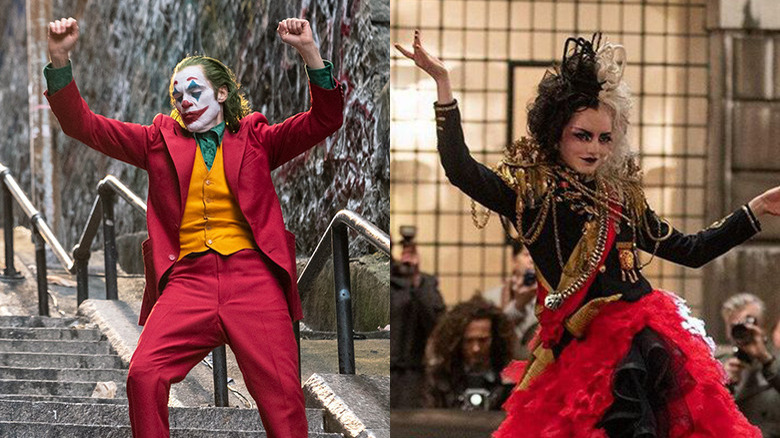Things Only Adults Notice In Cruella
"Cruella" is the story of how the notorious puppy-kidnapping fashionista first introduced in "101 Dalmatians" fell into her monochromatic villainy. It shows her struggles within the fashion industry of the 1970s and how she became the cackling psychopath we all know and love to hate.
Considering her place in the Disney pantheon, one would think any Cruella-centered movie would be solely for kids, but that isn't quite the case. The film has a PG-13 rating — a significant difference from the family-friendly original "101 Dalmatians," and an increasingly common approach to ratings for Disney. As with "Maleficent," the studio's earlier exploration of a famed villainess' origin story, "Cruella" contains elements that seem geared far more to adults. From the film's style and presentation to the parallels it has with other grown-up films, it's definitely a grittier offering from Disney. The House of Mouse is always innovating, and has realized they can appeal to older fans who crave something more mature.
The film captures a bygone era in an extremely chaotic but appealing way. The '70s throwback, aided by the soundtrack and fashion, will suit viewers who understand how different things used to be. Let's go through some notable examples of things only adults will notice in "Cruella."
The presence of alcohol (and the absence of smoking)
It's far from the first Disney movie to do this, but adults in the audience will notice that "Cruella" slips in a few grown-up vices for its characters. It's a little out of character for the studio's brand, but including alcohol in its films hasn't harmed Disney's long-maintained squeaky-clean image.
"101 Dalmatians," "Beauty and the Beast," "Sleeping Beauty," and "The Great Mouse Detective," all classic Disney films, have scenes depicting the consumption of alcohol. Also, who could forget the infamously trippy pink elephant montage from "Dumbo," after the pint-sized pachyderm accidentally ingests some hooch? Throughout "Cruella," we see several characters enjoying fancy cocktails at parties and liquid lunches.
Alcohol is the only vice the film sees fit to include; gone is the sinister cigarette holder Cruella De Vil's animated version carried. It would have made sense to show smoking both for character consistency and for the setting; smoking was a far more common in the 1970s, and is still associated with the fashion industry. Walt Disney himself was a fan of tobacco — a truth the company has wiped from history via photo trickery. The House of Mouse has pledged to stop depicting smoking under certain circumstances, though, and that commitment is more important than depicting era-appropriate addictions.
Kids probably won't notice either the presence of alcohol or the absence of smoking, but they'll be more conspicuous to adults.
Estella & Cruella
Disney is no stranger to cartoonish madness. From Maleficent in "Sleeping Beauty" to Ursula in "The Little Mermaid," Disney has crafted some of pop culture's most memorable and watchable villains.
Although these characters have fans of all ages, truly committed supporters tend to be adults, who often have a deeper understanding of onscreen evildoers' complex motivations and psychologies. Case in point: Cruella has two completely distinct selves (both played by Emma Stone). Adults will understand how this fractured psyche — symbolized by the half-black, half-white color of her hair — impacts Cruella's behavior.
First, there's Estella, a mildly sassy but hopelessly klutzy hot mess who's happy to stay in her lane. Then there's her less relatable side, Cruella — a flamboyant, chaotically self-obsessed schemer with grand plans for mayhem. When presented with the central conflict, Estella is forced behind the curtain while Cruella takes center stage.
Adults will also pick up on cultural context. The divide in Cruella's personality is in the tradition of scores of classic stories, such as "Dr. Jekyll and Mr. Hyde." Fans might also see echoes of DC villain Two-Face, who, like Cruella, has an outward appearance that reflects an inner duality.
Disney still hates parents
It's a cliche that if there is a parent in a Disney film, they are most likely not going to see their kid's graduation. From Simba's father to Lilo's parents and Bambi's mom, regardless of your location or species, if you produce life within the Disney universe, your odds of meeting an untimely demise are much higher than normal. It's become such a trope that in many parodies of the Disney formula, the fate of the main character's parents is now a standard running joke.
Disney, despite its squeaky clean reputation, often also has the villains in their stories meet their end in rather sickening fashion. From Bill Sykes being hit by a train in "Oliver & Company" to Judge Frollo falling into molten metal in "The Hunchback of Notre Dame," Disney has racked up quite the body count. True to form, "Cruella" utilizes its PG-13 rating and opts to lean into this cliche of parental death with gusto. A young Cruella, known then as Estella, sees her mother meet her end during the first act of the film. We see Estella chased from a fancy party by angry Dalmatians, who end up knocking her poor mother off a cliff.
This definitely ranks as one of the grislier ways a Disney character has been shuffled off the mortal coil, especially in recent memory.
The punk rock revolution
Any kids who see "Cruella" will be in for an education on a genre of music that adults are already familiar with — punk rock.
Punk started breaking into the mainstream in the mid-to-late '70s, giving voice to a burgeoning revolution against the more excessive style of mainstream music at the time. The punk bands prevalent during this era operated under a DIY mentality, often self-producing and distributing their music independently. The movement gained traction in the United States — with the likes of the Ramones — and the United Kingdom, with groups like the Sex Pistols. It was counter-culture, politically charged, hyper-sexual and in your face.
It's also a key factor in the plot and style of the film, especially Cruella fighting back against the upper class through aggressively charged art. The UK's punk rock revolution serves as the backdrop for Cruella's rise to prominence, and the film takes full advantage of it visually. Cruella, shown in a quickly paced montage, stages several raucous public reveals of her twisted new fashion line. She not only utilizes motorcycles and a garbage truck, but goes as far as to stage a punk rock fashion show right outside her arch-rival's event.
The choice to set the film in such an important era for fashion and music is a clever one. The chaotic nature of the music and the visuals suits Cruella and her ever-escalating mix of insanity and theatricality. Adults are far more likely to appreciate the time capsule aspect of "Cruella" and its use of one of art's most tumultuous eras.
Use of media manipulation
The movie's story draws on the fickle nature of the fashion industry, but "Cruella" doesn't stop at just the internal workings of the business. The film also has a bit to say about how brands use the media to alter public perception.
Introduced early in the film is Cruella's childhood friend Anita Darling (Kirby Howell-Baptiste), who in adulthood has become a journalist. Immediately recognizing Anita as her former classmate, Cruella is eager to enter into a unique business arrangement with her. Taking advantage of their connection, Cruella coaxes Anita into giving her forthcoming public takedown of the Baroness' fashion line a boost in terms of coverage.
The media has often been used to shape people's perspectives and perceptions for the benefit of those looking to sell a product. This is obviously far from exclusive to the fashion industry — examples exist in almost every industry, both digital and physical, known to man. That said, it's a particularly important aspect of fashion, and "Cruella" does a wickedly good job of showcasing its utility. Adults will pick up on the concepts of brand awareness, demographics, and the manner in which the media talks to consumers. Meanwhile, younger kids will more than likely watch the movie in blissful ignorance with regards to these themes.
The fickle nature of the fashion industry
Kids don't perceive fashion the same way that adults do, as it's an industry built on what's hot versus what's not. Words like "reinventing" and "trends" pop up quite frequently in the discussion around fashion, and for good reason. They are the backbone of an industry in which designers depend on their ability to churn out exciting new looks on a regular basis. In "Cruella," we see Estella constantly innovating with bizarre designs which end up catching the eye of the Baroness. This of course results in Estella learning just how cutthroat the Baroness — and by extension, the entire fashion industry — truly is.
The film has a lot in common with "The Devil Wears Prada," another movie that uses the toxic side of fashion in its story. Both films follow an unpolished rookie working in the footsteps of a heinously conceited fashion mentor. In "The Devil Wears Prada," the rookie is Anne Hathaway and the mentor is Meryl Streep — and their dynamic isn't all that dissimilar to the one between Cruella and the Baroness in "Cruella." The major differences between the two films lie in their tones and styles of execution. "The Devil Wears Prada" is a more down to earth, modern narrative about what happens when you lose sight of who you really are. Meanwhile, "Cruella" is more stylized and has a lot to say about identity as well as embracing your inner dark side.
The toxic and cutthroat underbelly of the fashion industry plays a big part in "Cruella," but it's aimed squarely at the adults in the audience. It'll fly over the heads of kids who are only concerned with whether or not their shoes are velcro.
The retro soundtrack
A film's soundtrack is the backbone of maintaining whatever tone and atmosphere the director is looking to create. Would "Risky Business" have been the same without "Old Time Rock and Roll" by Bob Seger and the Silver Bullet Band? Would the torture scene in "Reservoir Dogs" have been complete "Stuck in the Middle with You" by Stealers Wheel? The answer to both of these is no, and they're both great examples of the way the soundtrack can profoundly affect the impact of a scene.
"Cruella" embraces its 1970s aesthetic not only through its visuals, but through the selection of songs chosen for the soundtrack. The punk rock revolution of the '70s, brought with it a tidal wave of memorable tracks, and this movie sees fit to cherry pick some of the catchiest earworms the era had to offer. The way those songs are utilized serves as one of the film's stronger points.
"Cruella" serves up many classic songs, such as "Stone Cold Crazy" by Queen, "Hush" by Deep Purple, "Should I Stay or Should I Go" by the Clash, and "I Wanna Be Your Dog” by the Stooges, just to name a few. Taken together, all of these songs add to the authenticity of the film's setting, and they also to make for a perfect sonic backdrop for Cruella's ever-growing insanity and popularity.
Similarities to Joker
Ever since it was announced Cruella De Vil would be getting her own movie, the internet has been saturated with comments labeling the film as a "Girlboss Joker."
Since the release of "Joker" in 2019, any film or show that portrays a person's steady unraveling into villainy and violence has been compared to it. It's a story that started being told far earlier than "Joker" — a couple of earlier examples, both involving "Joker" co-star Robert De Niro, are "Taxi Driver" and "King of Comedy." Still, Joaquin Phoenix's performance earned him an Oscar, so it stands to reason that people would see echoes of "Joker" in superficially similar films.
Cruella and "Joker" protagonist Arthur Fleck definitely share some similarities in the way they are presented in their respective films. Both had unpleasant childhoods which resulted in grim adulthoods that found them grappling with instability as well as unpleasant lines of work. Additionally, they both have a moment within their films that can be seen as a sort of "coming out" — Arthur debuting his Joker persona on Murray Franklin's show, and Estella debuting her Cruella persona at the Baroness' party.
One visual similarity the films share is how as the main character's mental state begins to degrade and their world becomes more chaotic, the world around them becomes more vibrant. It's a smart way of displaying change, and one that shows just how happy both characters are when they're indulging in their chaotic sides. Additionally, the song "Smile" as performed by Jimmy Durante can be heard during pivotal moments in both films.
